Nursing Leadership: Patient to Nurse Ratio in Aged Care Settings
VerifiedAdded on 2022/10/06
|6
|1125
|144
Presentation
AI Summary
This presentation addresses the critical issue of patient-to-nurse ratios in aged care settings, highlighting the implications of inadequate staffing on patient safety and nurse well-being. It examines the problem of declining full-time equivalent registered nurses and enrolled nurses in residential care and the aged care sector, emphasizing the impact on patient care quality, workload, and potential clinical errors. The presentation explores current initiatives, such as the Victorian model and the Safe Patient Care Act, and emphasizes the objectives of decreasing nurse turnover and providing psychological support. It proposes that effective leadership, through reevaluation of nursing management, transformational leadership, and incentive structures, can mitigate these challenges and improve nurse retention. The presentation concludes by underscoring the essential role of nurses and leadership in maintaining appropriate patient-to-nurse ratios, ultimately contributing to a safer and more supportive healthcare environment for both patients and healthcare professionals.
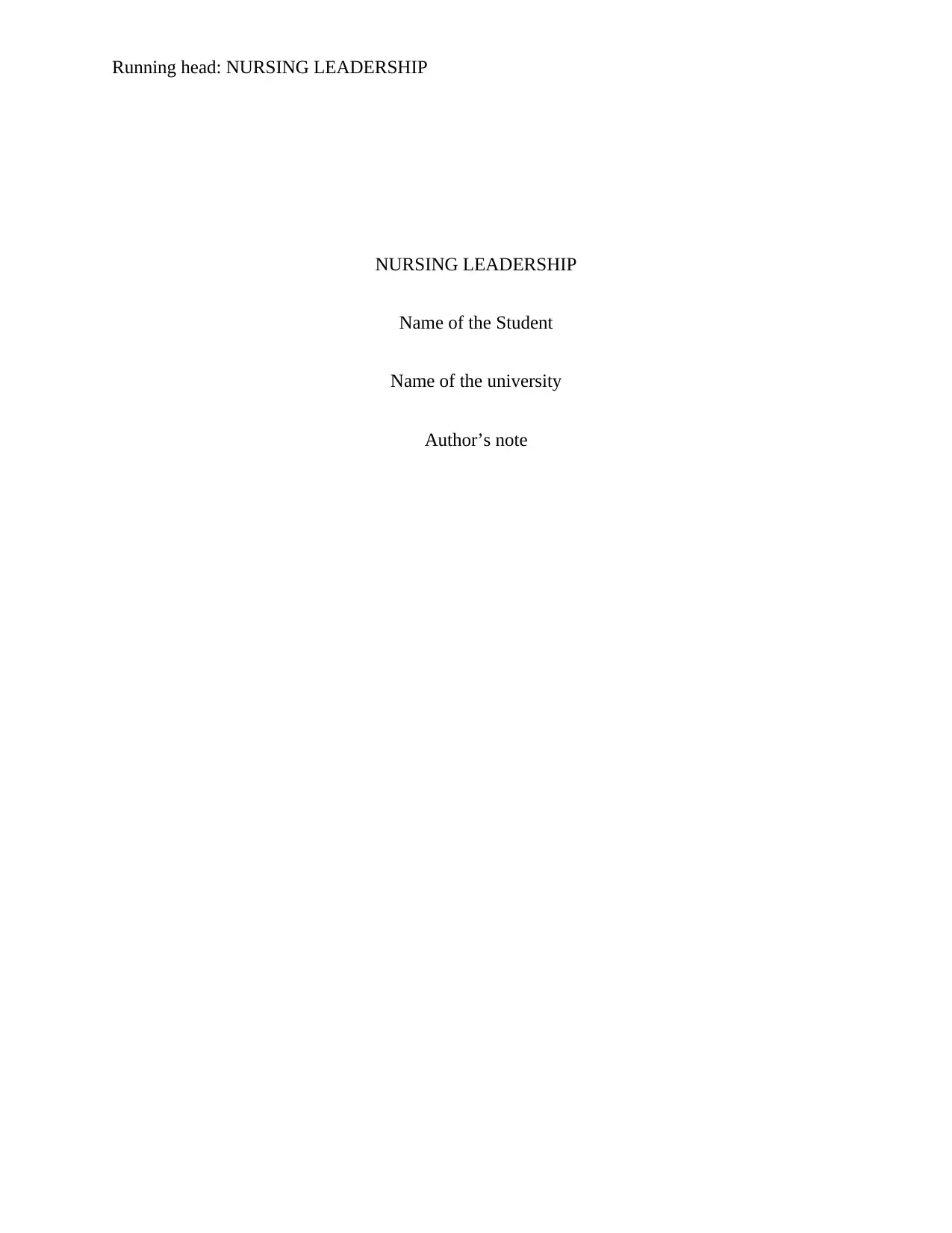
Running head: NURSING LEADERSHIP
NURSING LEADERSHIP
Name of the Student
Name of the university
Author’s note
NURSING LEADERSHIP
Name of the Student
Name of the university
Author’s note
Paraphrase This Document
Need a fresh take? Get an instant paraphrase of this document with our AI Paraphraser
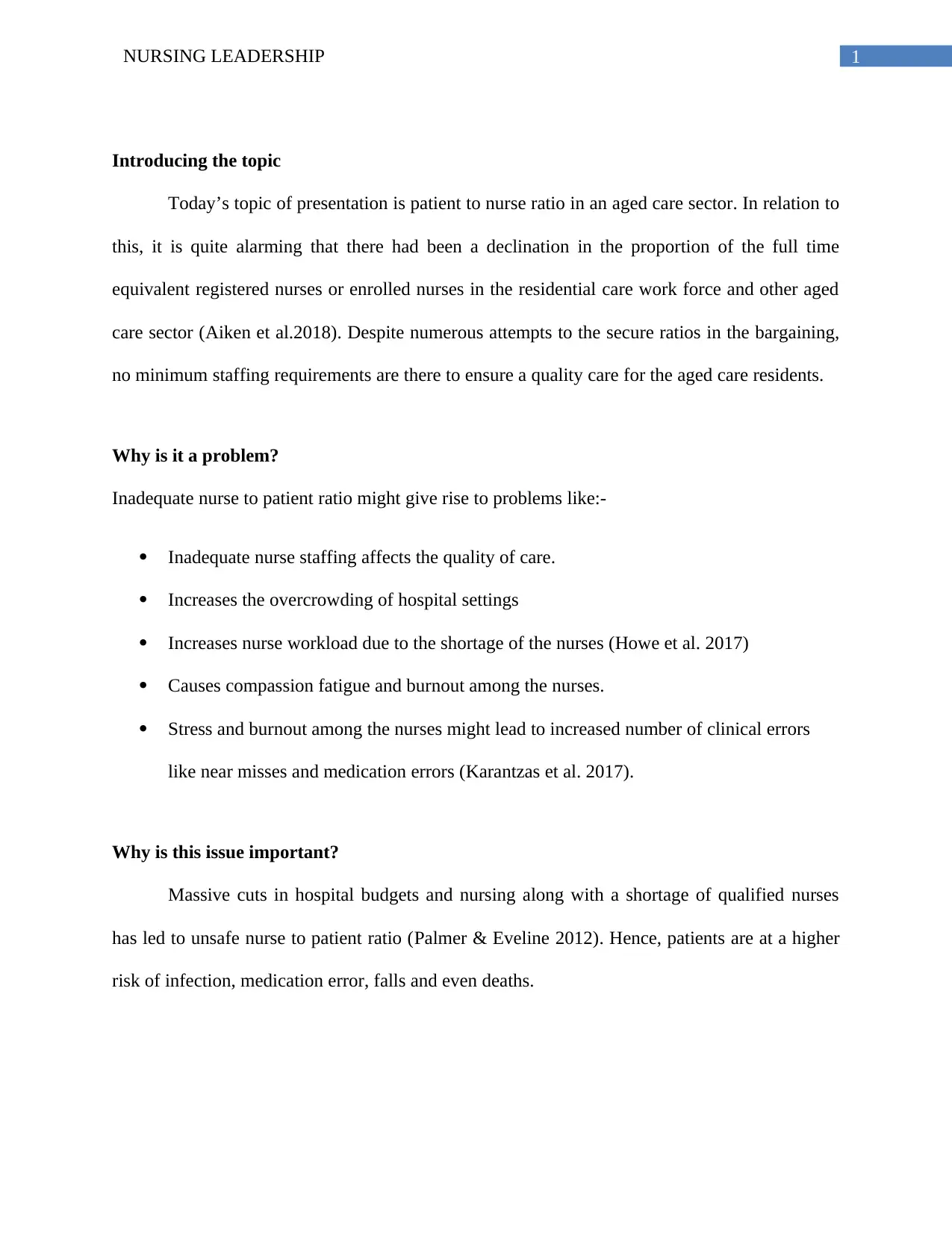
1NURSING LEADERSHIP
Introducing the topic
Today’s topic of presentation is patient to nurse ratio in an aged care sector. In relation to
this, it is quite alarming that there had been a declination in the proportion of the full time
equivalent registered nurses or enrolled nurses in the residential care work force and other aged
care sector (Aiken et al.2018). Despite numerous attempts to the secure ratios in the bargaining,
no minimum staffing requirements are there to ensure a quality care for the aged care residents.
Why is it a problem?
Inadequate nurse to patient ratio might give rise to problems like:-
Inadequate nurse staffing affects the quality of care.
Increases the overcrowding of hospital settings
Increases nurse workload due to the shortage of the nurses (Howe et al. 2017)
Causes compassion fatigue and burnout among the nurses.
Stress and burnout among the nurses might lead to increased number of clinical errors
like near misses and medication errors (Karantzas et al. 2017).
Why is this issue important?
Massive cuts in hospital budgets and nursing along with a shortage of qualified nurses
has led to unsafe nurse to patient ratio (Palmer & Eveline 2012). Hence, patients are at a higher
risk of infection, medication error, falls and even deaths.
Introducing the topic
Today’s topic of presentation is patient to nurse ratio in an aged care sector. In relation to
this, it is quite alarming that there had been a declination in the proportion of the full time
equivalent registered nurses or enrolled nurses in the residential care work force and other aged
care sector (Aiken et al.2018). Despite numerous attempts to the secure ratios in the bargaining,
no minimum staffing requirements are there to ensure a quality care for the aged care residents.
Why is it a problem?
Inadequate nurse to patient ratio might give rise to problems like:-
Inadequate nurse staffing affects the quality of care.
Increases the overcrowding of hospital settings
Increases nurse workload due to the shortage of the nurses (Howe et al. 2017)
Causes compassion fatigue and burnout among the nurses.
Stress and burnout among the nurses might lead to increased number of clinical errors
like near misses and medication errors (Karantzas et al. 2017).
Why is this issue important?
Massive cuts in hospital budgets and nursing along with a shortage of qualified nurses
has led to unsafe nurse to patient ratio (Palmer & Eveline 2012). Hence, patients are at a higher
risk of infection, medication error, falls and even deaths.
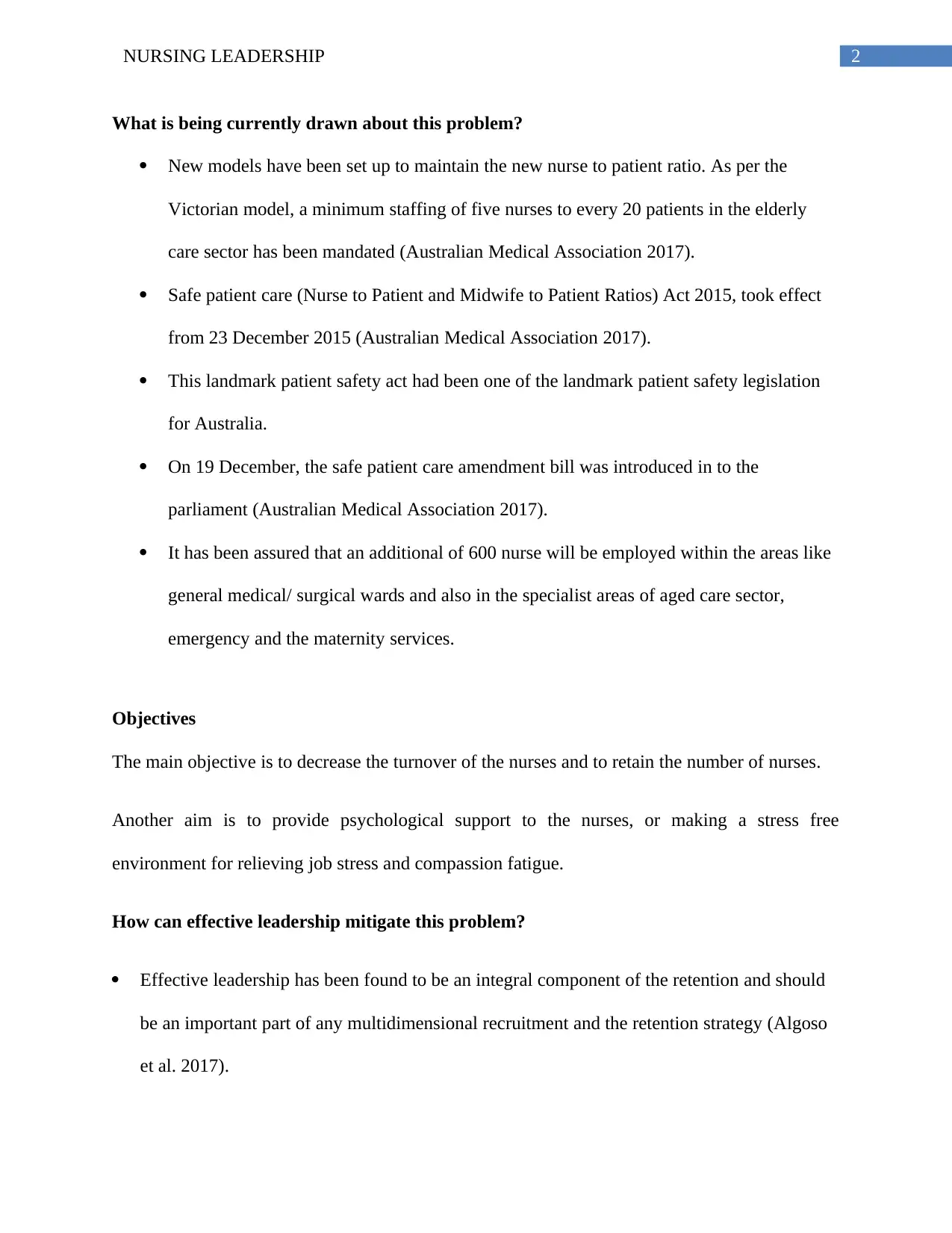
2NURSING LEADERSHIP
What is being currently drawn about this problem?
New models have been set up to maintain the new nurse to patient ratio. As per the
Victorian model, a minimum staffing of five nurses to every 20 patients in the elderly
care sector has been mandated (Australian Medical Association 2017).
Safe patient care (Nurse to Patient and Midwife to Patient Ratios) Act 2015, took effect
from 23 December 2015 (Australian Medical Association 2017).
This landmark patient safety act had been one of the landmark patient safety legislation
for Australia.
On 19 December, the safe patient care amendment bill was introduced in to the
parliament (Australian Medical Association 2017).
It has been assured that an additional of 600 nurse will be employed within the areas like
general medical/ surgical wards and also in the specialist areas of aged care sector,
emergency and the maternity services.
Objectives
The main objective is to decrease the turnover of the nurses and to retain the number of nurses.
Another aim is to provide psychological support to the nurses, or making a stress free
environment for relieving job stress and compassion fatigue.
How can effective leadership mitigate this problem?
Effective leadership has been found to be an integral component of the retention and should
be an important part of any multidimensional recruitment and the retention strategy (Algoso
et al. 2017).
What is being currently drawn about this problem?
New models have been set up to maintain the new nurse to patient ratio. As per the
Victorian model, a minimum staffing of five nurses to every 20 patients in the elderly
care sector has been mandated (Australian Medical Association 2017).
Safe patient care (Nurse to Patient and Midwife to Patient Ratios) Act 2015, took effect
from 23 December 2015 (Australian Medical Association 2017).
This landmark patient safety act had been one of the landmark patient safety legislation
for Australia.
On 19 December, the safe patient care amendment bill was introduced in to the
parliament (Australian Medical Association 2017).
It has been assured that an additional of 600 nurse will be employed within the areas like
general medical/ surgical wards and also in the specialist areas of aged care sector,
emergency and the maternity services.
Objectives
The main objective is to decrease the turnover of the nurses and to retain the number of nurses.
Another aim is to provide psychological support to the nurses, or making a stress free
environment for relieving job stress and compassion fatigue.
How can effective leadership mitigate this problem?
Effective leadership has been found to be an integral component of the retention and should
be an important part of any multidimensional recruitment and the retention strategy (Algoso
et al. 2017).
⊘ This is a preview!⊘
Do you want full access?
Subscribe today to unlock all pages.

Trusted by 1+ million students worldwide
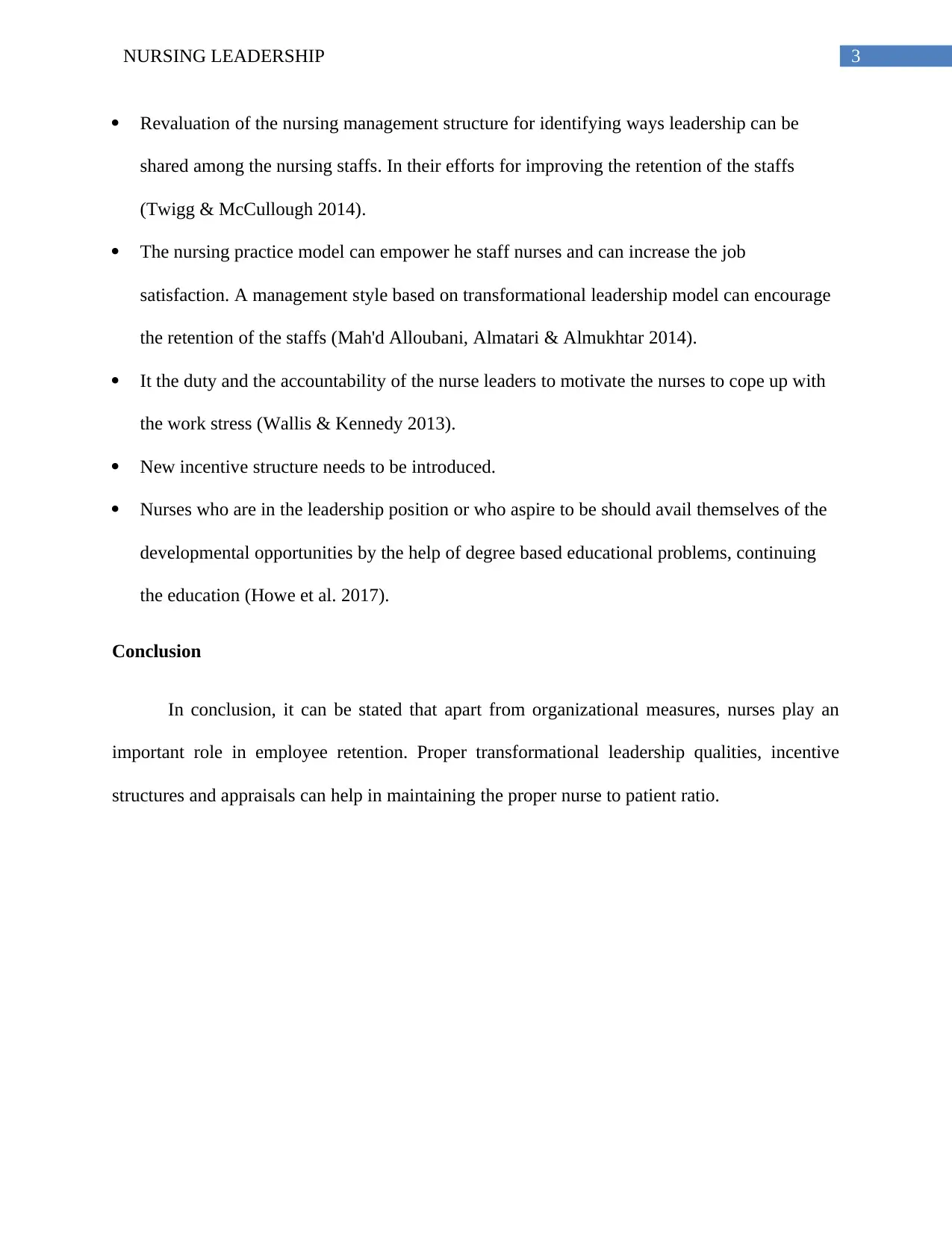
3NURSING LEADERSHIP
Revaluation of the nursing management structure for identifying ways leadership can be
shared among the nursing staffs. In their efforts for improving the retention of the staffs
(Twigg & McCullough 2014).
The nursing practice model can empower he staff nurses and can increase the job
satisfaction. A management style based on transformational leadership model can encourage
the retention of the staffs (Mah'd Alloubani, Almatari & Almukhtar 2014).
It the duty and the accountability of the nurse leaders to motivate the nurses to cope up with
the work stress (Wallis & Kennedy 2013).
New incentive structure needs to be introduced.
Nurses who are in the leadership position or who aspire to be should avail themselves of the
developmental opportunities by the help of degree based educational problems, continuing
the education (Howe et al. 2017).
Conclusion
In conclusion, it can be stated that apart from organizational measures, nurses play an
important role in employee retention. Proper transformational leadership qualities, incentive
structures and appraisals can help in maintaining the proper nurse to patient ratio.
Revaluation of the nursing management structure for identifying ways leadership can be
shared among the nursing staffs. In their efforts for improving the retention of the staffs
(Twigg & McCullough 2014).
The nursing practice model can empower he staff nurses and can increase the job
satisfaction. A management style based on transformational leadership model can encourage
the retention of the staffs (Mah'd Alloubani, Almatari & Almukhtar 2014).
It the duty and the accountability of the nurse leaders to motivate the nurses to cope up with
the work stress (Wallis & Kennedy 2013).
New incentive structure needs to be introduced.
Nurses who are in the leadership position or who aspire to be should avail themselves of the
developmental opportunities by the help of degree based educational problems, continuing
the education (Howe et al. 2017).
Conclusion
In conclusion, it can be stated that apart from organizational measures, nurses play an
important role in employee retention. Proper transformational leadership qualities, incentive
structures and appraisals can help in maintaining the proper nurse to patient ratio.
Paraphrase This Document
Need a fresh take? Get an instant paraphrase of this document with our AI Paraphraser
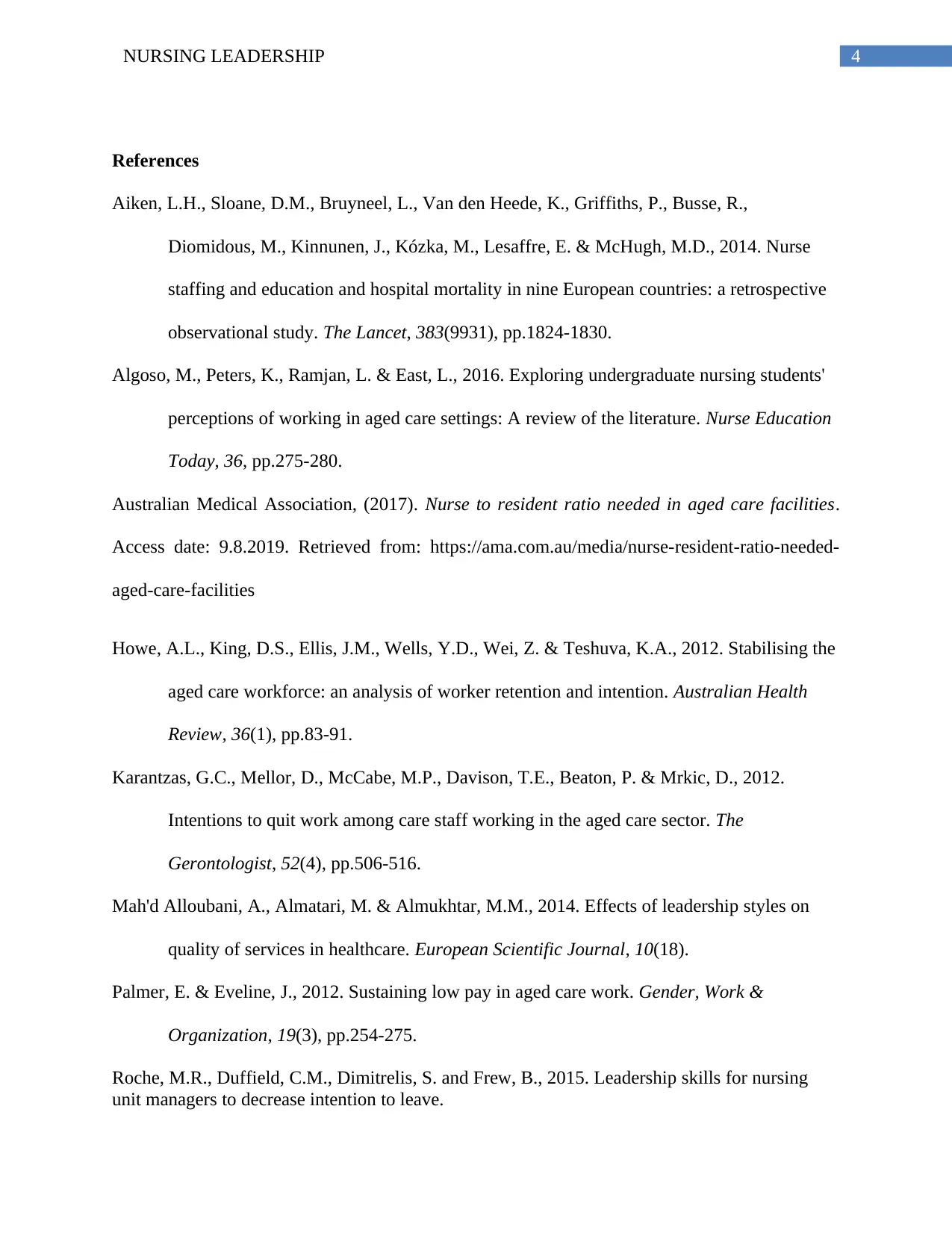
4NURSING LEADERSHIP
References
Aiken, L.H., Sloane, D.M., Bruyneel, L., Van den Heede, K., Griffiths, P., Busse, R.,
Diomidous, M., Kinnunen, J., Kózka, M., Lesaffre, E. & McHugh, M.D., 2014. Nurse
staffing and education and hospital mortality in nine European countries: a retrospective
observational study. The Lancet, 383(9931), pp.1824-1830.
Algoso, M., Peters, K., Ramjan, L. & East, L., 2016. Exploring undergraduate nursing students'
perceptions of working in aged care settings: A review of the literature. Nurse Education
Today, 36, pp.275-280.
Australian Medical Association, (2017). Nurse to resident ratio needed in aged care facilities.
Access date: 9.8.2019. Retrieved from: https://ama.com.au/media/nurse-resident-ratio-needed-
aged-care-facilities
Howe, A.L., King, D.S., Ellis, J.M., Wells, Y.D., Wei, Z. & Teshuva, K.A., 2012. Stabilising the
aged care workforce: an analysis of worker retention and intention. Australian Health
Review, 36(1), pp.83-91.
Karantzas, G.C., Mellor, D., McCabe, M.P., Davison, T.E., Beaton, P. & Mrkic, D., 2012.
Intentions to quit work among care staff working in the aged care sector. The
Gerontologist, 52(4), pp.506-516.
Mah'd Alloubani, A., Almatari, M. & Almukhtar, M.M., 2014. Effects of leadership styles on
quality of services in healthcare. European Scientific Journal, 10(18).
Palmer, E. & Eveline, J., 2012. Sustaining low pay in aged care work. Gender, Work &
Organization, 19(3), pp.254-275.
Roche, M.R., Duffield, C.M., Dimitrelis, S. and Frew, B., 2015. Leadership skills for nursing
unit managers to decrease intention to leave.
References
Aiken, L.H., Sloane, D.M., Bruyneel, L., Van den Heede, K., Griffiths, P., Busse, R.,
Diomidous, M., Kinnunen, J., Kózka, M., Lesaffre, E. & McHugh, M.D., 2014. Nurse
staffing and education and hospital mortality in nine European countries: a retrospective
observational study. The Lancet, 383(9931), pp.1824-1830.
Algoso, M., Peters, K., Ramjan, L. & East, L., 2016. Exploring undergraduate nursing students'
perceptions of working in aged care settings: A review of the literature. Nurse Education
Today, 36, pp.275-280.
Australian Medical Association, (2017). Nurse to resident ratio needed in aged care facilities.
Access date: 9.8.2019. Retrieved from: https://ama.com.au/media/nurse-resident-ratio-needed-
aged-care-facilities
Howe, A.L., King, D.S., Ellis, J.M., Wells, Y.D., Wei, Z. & Teshuva, K.A., 2012. Stabilising the
aged care workforce: an analysis of worker retention and intention. Australian Health
Review, 36(1), pp.83-91.
Karantzas, G.C., Mellor, D., McCabe, M.P., Davison, T.E., Beaton, P. & Mrkic, D., 2012.
Intentions to quit work among care staff working in the aged care sector. The
Gerontologist, 52(4), pp.506-516.
Mah'd Alloubani, A., Almatari, M. & Almukhtar, M.M., 2014. Effects of leadership styles on
quality of services in healthcare. European Scientific Journal, 10(18).
Palmer, E. & Eveline, J., 2012. Sustaining low pay in aged care work. Gender, Work &
Organization, 19(3), pp.254-275.
Roche, M.R., Duffield, C.M., Dimitrelis, S. and Frew, B., 2015. Leadership skills for nursing
unit managers to decrease intention to leave.

5NURSING LEADERSHIP
Twigg, D. & McCullough, K., 2014. Nurse retention: A review of strategies to create and
enhance positive practice environments in clinical settings. International journal of
nursing studies, 51(1), pp.85-92.
Wallis, A. & Kennedy, K.I., 2013. Leadership training to improve nurse retention. Journal of
Nursing Management, 21(4), pp.624-632.
Twigg, D. & McCullough, K., 2014. Nurse retention: A review of strategies to create and
enhance positive practice environments in clinical settings. International journal of
nursing studies, 51(1), pp.85-92.
Wallis, A. & Kennedy, K.I., 2013. Leadership training to improve nurse retention. Journal of
Nursing Management, 21(4), pp.624-632.
⊘ This is a preview!⊘
Do you want full access?
Subscribe today to unlock all pages.

Trusted by 1+ million students worldwide
1 out of 6
Related Documents
Your All-in-One AI-Powered Toolkit for Academic Success.
+13062052269
info@desklib.com
Available 24*7 on WhatsApp / Email
![[object Object]](/_next/static/media/star-bottom.7253800d.svg)
Unlock your academic potential
Copyright © 2020–2025 A2Z Services. All Rights Reserved. Developed and managed by ZUCOL.





